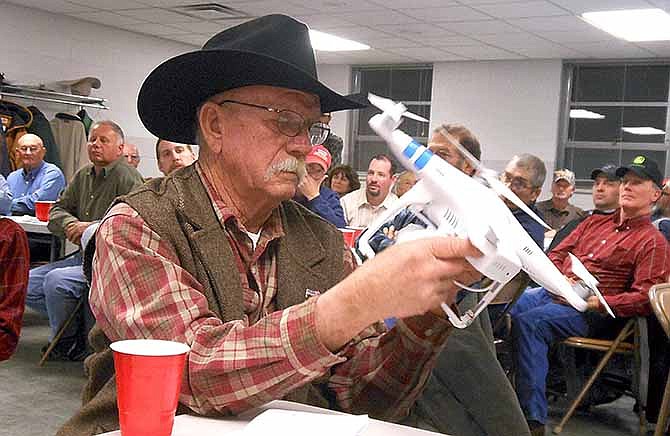MOUNT VERNON, Mo. (AP) - Jim McCann hasn't taught his grandchildren how to drive a tractor yet, but they may already be able to teach him how to operate a piece of equipment that could be in farming's future.
McCann, of Lawrence County, is president of the Missouri Cattlemen's Association and was among more than 100 farmers who attended the 90th annual Lawrence County Soils and Crops Conference earlier this month.
Along with the usual topics - efficiently feeding hay, using cover crops, etc. - was a discussion on how unmanned airplanes, sometimes called drones, could benefit agriculture. It was led by Bill Wiebold, who when he is not piloting the small planes is the state soybean specialist with University of Missouri Extension.
Wiebold brought two planes, discussed how they operate and the legalities that come with using them.
"I really think there's a lot of opportunity with these things we're going to talk about," said Wiebold, who also said at first that he was hesitant to call them "drones" because of possible negative connotations.
Wiebold said each farmer would have their own reasons for wanting to use a drone, which costs about $1,000 plus $300 for a camera.
McCann, who has about 500 head of cattle, said they would be a "wonderful time saver," especially during inclement weather.
"If you're checking cattle, it would be much simpler and a whole lot nicer," he said. "If you're checking cows that are calving, it would cut your time by probably 75 percent."
Wiebold presented a video that was taken from one of the drones as it hovered over a crop field at about 175 feet. The footage was slightly shaky, Wiebold said, because there was a 20 mph wind gust.
"It's kind of fun to do, unless it crashes," Wiebold said, adding he crashed the drone shortly after taking the video.
Brent Drury, 23, of Strafford, said he'll probably buy a drone within a couple weeks.
"I'd be using it for checking livestock in the field," said Drury, who grows wheat, soybeans and alfalfa at J&K Farms east of Springfield. He also has a 300-acre cattle farm in that area.
"I thought it was very reasonable as far as how much it costs," he said.
Part of the discussion included legal and privacy issues that come with owning and operating a drone.
The Federal Aviation Administration considers drone users to be hobbyists, and the drones are not approved for commercial use. Drones can be flown under 700 feet, and the FAA considers that height to be non-navigational, meaning it will not interfere with airplanes, Wiebold said. However, there are different rules for those who live close to airports.
Farmers can fly over their own property, Wiebold said, and outlined a few other rules: Operators must stay away from populated areas; flying near spectators is not allowed until the operator knows how to fly; and the drone cannot go higher than 400 feet if it is within three miles of an airport.
There also is an iPhone application Wiebold said he uses to live stream video from the camera on the drone to his phone, and there are also goggles an operator can wear to view what the drone's camera sees. But he doesn't advise flying the drone too far before the operator is comfortable with navigating.
"My advice is keep it within sight," Wiebold said. "The idea of a drone, really, is that it can go beyond line of sight. And in many cases you may want to do that, but at least until you get really good at running these things, keep it within sight."
Wiebold said the privacy rules are open to a lot of different interpretations and lots of different laws.
"But that's where even counties and state governments may in fact have some of those privacy rules," he said. "So it's kind of several different agencies that we're going to have to deal with."
Drury said he thinks privacy will eventually become a huge issue.
"There's people in every aspect of life that are going to take advantage and abuse the system," Drury said.
Within the next 10 years, Drury said he thinks a lot of laws and regulations will be passed, making drones more difficult to own without being certified.
The drones Wiebold presented run on five batteries, and he changes them after a 10-minute lap.
Even though the drone's batteries may not last long, Drury said, they can be used every day to get a live feed of what's happening below.
"It's almost kind of scary, but that's the kind of world that we've grown into," he said.
Drury also said he thinks young farmers will look at the technology as the future and something that could be extremely useful.
"I think these drones are going to be a huge thing," Drury said.
Drury said he didn't play a lot of video games growing up, but the hand-eye coordination skills he developed operating farm equipment will help him fly a drone more easily.
McCann said most kids have played so many video games that they probably wouldn't even have to think about it.
"I know I've got a bunch of grandkids that would be flying that thing 15 minutes after you got it," he said.
Information from: The Joplin (Mo.) Globe, http://www.joplinglobe.com

